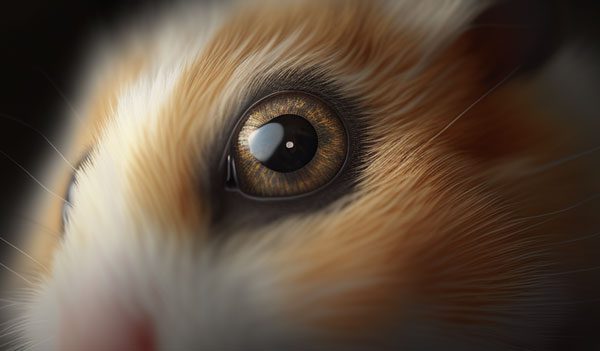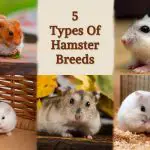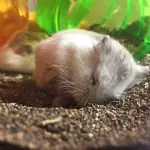Hamster Bulging Eye – Is Exophthalmos in Hamster Dangerous?
Hamsters are tiny and cute, but very sensitive, exposing vulnerabilities to a wide range of health issues. And a great example of this having a bulging eye.
So, what is a hamster bulging eye? Is exophthalmia in hamster dangerous? If your hamster receives a bugling eye, it is definitely experiencing too much pain and going to face some major consequences. And you should address it immediately.
To assist you in detail, here we discuss the root causes of the bugling eye phenomenon, addressing approaches, and preventive measures.
What is Exophthalmos in Hamster and Is It Dangerous?
Exophthalmos is the clinical term for “bugling eye” (the term “bugling eye” is used as a conversational language). Exophthalmos is also known as proptosis.
Hamsters’ eye setting, characterized by small eyes with complete orbital sinuses, accommodates increased chances of eye pop-out from the setting.

And as mentioned earlier, a bugling eye is very painful for hamsters. If the problem is not addressed, it becomes threatening (or even dangerous) to the hamster’s health. The considered health issues are blindness, deteriorated health due to not eating, self-harm for pain, etc.
In short, it can create more critical health issues for your hamster. To be sure that your hamster has exophthalmos, you should check the signs below.
- The eye is out of place
- It is not opening the eye due to pain, and the covering skin is not looking infected
- An enlargement of the eyeball (s)
- The eye is red and liquid is coming out
- Not eating
Causes of Eye Bugling in Hamsters
Below are the most likely causes of eye bugling in hamsters along with the addressing approaches.

Virus Infection
Well, in this case, the very common virus is the Sialodacryoadenitis Virus. It is very infectious, and the scientific explanation might be critical to you.
Just remember, it transmits through aerosol, contacts with an already infected nasal passage, physical contact with saliva from an already infected living object, etc.
Precautions
In this case, you must take the following actions:
- Restrict your hamster’s movement here and there. It is preferable to confine within the cage
- Keep the cage warm
- No one should be allowed near the cage
- Provide quality food
- Use ophthalmic lubricants and fluids
- Consult a vet
Lack of Hygiene
The importance of hygiene in maintaining the hamster’s health cannot be overstated. If you don’t clean the cage regularly, change the water frequently, etc., your hamster can get infected by bacteria. The infection can further cause exophthalmos.

Precautions
So, you must take care of the following as protective measures.
- Clean the cage (bed pads, toys, exercise items, etc.) frequently
- Change the water more often
- Place the cage on a dry surface
- Your Hamster is Experiencing Trauma
Stress or trauma is another crucial factor in triggering exophthalmos in hamsters. The trauma usually causes strain in the periorbital area (neck to back) of the hamster, and the eyes pop out.
You can check the traumatized context by touching the body. You will sense its body is cold, shriveling, and has a higher pulse rate, along with an eye out of position.
Precautions
You should use the addressing methods listed below.
- Take it to its familiar environment (the cage or your room)
- Enhance the comfort of the cage
- Put some vegetables on the food tray
- If the eye doesn’t come back to normal, take it to the vet
Mishandling
Any accidental pressure on it can cause eye bulging. For instance, if it is on the bed or couch and you haven’t noticed, your body’s pressure will initiate the bugling.
In addition, your little brother or sister can mishandle it unintentionally, putting pressure on its body. Such a case can also raise the problem.
Precautions
You can only take precautions here.
- Don’t hold it too strong
- Before lying on the bed or sitting on a chair, take a look around first
- Don’t allow kids to hold it without your supervision
Other Health Issues That Can Cause Hamster Bulging Eye
Your hamster can have a bugling eye due to suffering from other health issues or diseases. Below is a list of solutions in the table.

| Other Health Issues | Solutions |
|---|---|
| Dental issues | Check the food before placing it in the cage, ensure proper nutrition, and hang a hard salt lick |
| Cheek pouch tumors | Massage the impacted area and consult with the vet |
| Contact with Allergenic Components | Identify what foods your hamster is allergic to and don’t provide those foods and don’t spray perfume or any cosmetic item |
| Glaucoma | Contact with the vet immediately |
Dental Problem
Many hamsters suffer from dental issues and receive exophthalmos. Dental issues usually arise from eating rotten food, having food particles stuck in the teeth for a long time, biting into a hidden solid particle in the food, having weak teeth, etc.
It is very problematic to resolve. Even experienced vets struggle to identify issues with the teeth. Sometimes, the solution comes from removing the eye to relieve the bugle-related pain.
Precautions
You can only take precautions.
- Check the food before placing it in the cage
- Ensure proper nutrition is provided, which is good for teeth
- Hang a hard salt lick in the cage; it will help the pet keep its teeth clean
Cheek Pouch Tumors
Cheek pouch tumors also cause eye bugling. These abscesses are usually formed from bacterial infections in the wounds. And the wounds are usually generated by the hamster’s encounter with the sharp edges of the objects in the cage.

Precautions
- Massage the impacted area of the cheeks
- Avoid the inclusion of wood shavings in the cage
- Use ointments that have antibiotics
- If you see that the abscesses are very serious (in color and shape), take the pet to the vet immediately
Contact with Allergenic Components
As mentioned earlier, hamsters are very sensitive. They are allergic to sprays, perfumes, certain foods, etc. If they contact any of them, the allergic characteristics result in an impact on the eyes.
Sometimes, if you spray things like mosquito repellent, air freshener, etc. in the room, its eyes can get hurt. Also, any sort of smoke (from cigarettes, pipes, cooking, fireplaces, etc.) can negatively impact its eyes.
Precautions
To limit this, you should do the following:
- Identify what foods your hamster is allergic to and don’t provide those foods
- Don’t spray perfume or any cosmetic item on it. Also, be careful when you use it. The extracts from the bottle can be carried by the wind and harm the pet’s eyes
Glaucoma
Glaucoma is the very direct cause of the hamster’s bugling eye. Here, the symptom is eyeball enlargement. This disease forces the optical organs to discharge more liquid than necessary, resulting in dried eyes.
Precautions
There is no particular treatment for this issue. Still, you can have mental peace as hamsters’ vision is very poor and blindness is not that big deal.
- Contact your vet immediately before it is too late
To identify “Glaucoma,” you can check this YouTube video as a practical guide:
Eye Injury
It is very certain that if your hamster receives any sort of eye injury, you will see the bugling eye of your pet. Hamsters’ eyes usually get injured while playing in the cage or running inside the room. Due to poor eyesight, they eventually hit solid objects, and their eyes get injured.

Precautions
You can try the below as preventive measures.
- Try not to keep any hard objects; spongey or foamy items are good
- Don’t leave any sharp metal on the floor; it may cause destruction to its eye
FAQs
Here are some common questions and their answers regarding exophthalmos and eye issues in hamsters.
Q: Can hamsters’ eyes fall out?
Literally, falling out is very rare. But getting it close to falling out is very common and mostly happens due to pressing it hard.
Q: Why are my hamster’s eyes turning white?
It is a common optical issue in old hamsters. This is a sign that your hamster has reached the end of its life cycle and is becoming blind.
Q: How do you treat a hamster’s swollen eye?
If the eye is swollen, the most probable cause is that it has become infected or injured. Take it to the vet immediately.
Q: What should you do if your hamster’s eye is popping out?
First, try to identify the reason behind the issue. If it is due to trauma, just allow it some time while importing more comfort into the cage. Again, if the issue is generated by infection, take it to a vet for suggestions regarding treatment and medicines.
Final Thoughts
We are hoping that our detailed elaboration on the hamster bugling eye will help you to evaluate the problem with your hamster’s eye. Further on, you will be able to check the right-now scenario regarding exophthalmos in hamster dangers.
If the danger level falls into the “right-now” category (you cannot do anything), take it to the vet. And if it’s for simple reasons like trauma, stress, or excessive pressure, take preventive measures to restrict repeat occurrences. Finally, we suggest you take your hamster to the vet once a month.




